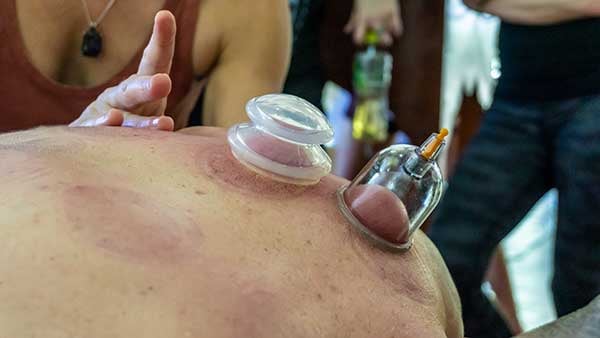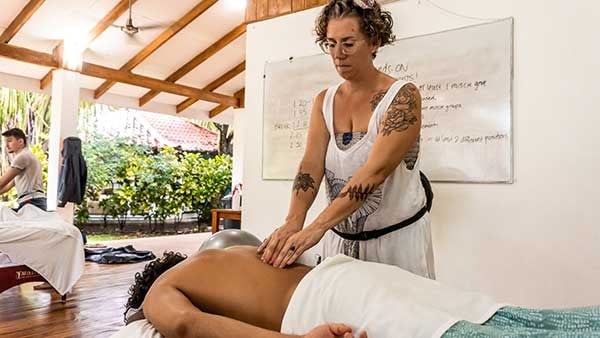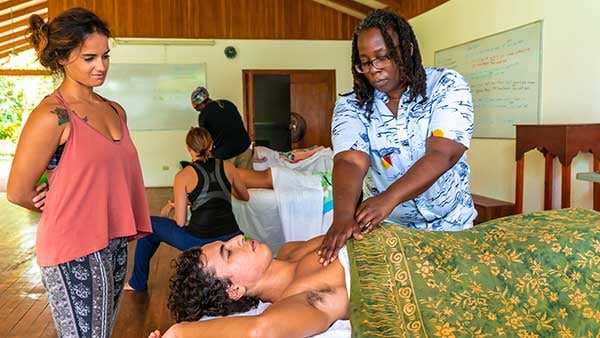In the world of massage therapy, there are various types of massage, all with their own distinct benefits. Getting to know these benefits can be good for the therapist and client alike. To introduce you to all the types of massage therapy and each of the advantages would take entirely too long for one article, so in this post we are going to look at deep tissue massage.

What is deep tissue massage?
This term can be misleading, as it is not necessarily one specific type of massage. Massage therapy educator, Beverley Giroud comments, “’Deep Tissue’ Massage is generally a term used to refer to a variety of techniques that are meant to provide relief for specific orthopedic conditions. The term “deep” can be misleading as not all of the techniques used need to be done with lots of pressure or inflict any level of discomfort (on either the client or the therapist.) Techniques often included under the “deep tissue” umbrella are neuromuscular massage, trigger point therapy, myofascial release, muscle energy techniques, cupping, and a variety of manual therapies from non-Western health care. Other terms used to characterize “deep tissue” massage are clinical massage, medical massage, and orthopedic massage.”

Beverley goes on to say, “Regardless of the terms used, a “deep tissue” massage will typically focus on reducing specific areas of tension, improve limited range of motion, pain reduction, and treatment of orthopedic injuries. Important aspects of this type of treatment are:
- Evaluation and assessment are needed in order to identify contraindications and qualify the client for safe treatment. Ethical therapists will recognize conditions that are beyond their scope or that will respond better to other therapies and will refer clients to the appropriate health care professional.
- The therapy should begin by defining client centered goals and treatment planning to include a variety of techniques and client self-care that provide a well-rounded approach.
- One should seek out a therapist with a skill set that builds upon the general techniques often used for relaxation focused massage. Look for a therapist with additional training and knowledge in pathologies, orthopedic injuries and assessments, knowledge of the effects of specific techniques and the ability to apply them using appropriate treatment strategies.

WHAT ARE THE BENEFITS OF DEEP TISSUE MASSAGE?
As we have learned, “deep tissue massage” is a broad term and serves more as an umbrella to different types of therapies used to treat specific areas of tension. Now, here is a list of some of the benefits of deep tissue massage.
- A specific area is targeted, meaning that treatment can be more effective. If a client comes in with a specific area that needs attention, deep tissue is a good option for treatment.
- Deep tissue massage can be used to increase range of motion in a certain area of the body. When a client comes in with limited mobility in a specific area, deep tissue works to release tension and improve their mobility and range of motion.
- It can be used to treat orthopedic injuries. Whether old or new, orthopedic injuries can be difficult to recover from. However, deep tissue massage is a great way to treat orthopedic injuries and get a client back up and feeling better in no time.
- It can help to reduce pain in a specific area of the body. Pain can be difficult to deal with, both for the person who suffers from it and the therapist treating it. However, deep tissue massage is a great way to relieve pain in specific areas of the body. Since its focus is on one certain area, the therapist is able to work on the area that is causing the pain, reducing the effects and alleviating pain.

The Costa Rica School of Massage Therapy focuses on preparing massage therapists to be highly skilled clinical therapists who are capable of delivering client centered, therapeutic massage. Our curriculum includes the foundational sciences that are instrumental in developing an educated and safe approach to body work, postural evaluation and injury assessment, advanced techniques to address common orthopedic injuries, and supervised practical clinical experience with a strong emphasis on critical thinking and problem-solving skills. We also include ethics, communication, and business practices that underscore the importance of the client-centered, professional experience.
The Costa Rica School of Massage Therapy is the world’s premier study abroad program for massage therapy. We offer a 600 hour to 750 hour COMTA Accredited Massage Therapy course which satisfies the licensing requirements for massage therapy in most of the United States. Additionally, we offer continuing education for massage therapists.






